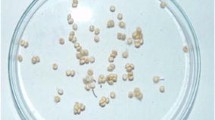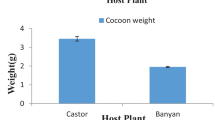Abstract
The present study was conducted to record the complete life cycle of oak tasar silk worm Anthraea proylei in the western Himalayan region of Uttarakhand, India. During this study the duration of larval instar stages were 4.80 ± 0.41, 4.00 ± 0, 4.80 ± 0.41, 8.00 ± 0 and 11.66 ± 0.72 days for 1st, 2nd, 3rd, 4th and 5th larval instars, respectively. The shortest duration of the larval stage was recorded for the 2nd instar (4.00 ± 00 days), while, longest duration of the larval stage was recorded for 5th instar (11.66 ± 0.72 days). All the larval stages were completed within 42 ± 10 days. After hatching, the larvae developed, which were elongated about 4.17 ± 0.36 mm long. The larvae covered with many brownish-black hairs and start feeding at the given food plant. After feeding the total weight was recorded 0.07 ± 0.006, 0.26 ± 0.02, 1.27 ± 0.17, 4.65 ± 0.86, 13.72 ± 1.10 for 1st, 2nd, 3rd, 4th and 5th larval instars respectively. The total length of all instars was 1.02 ± 0.03, 2.39 ± 0.43, 6.12 ± 0.12, 7.44 ± 0.43, 10.25 ± 0.17 for 1st, 2nd, 3rd, 4th and 5th larval instars respectively. Larvae were reddish-brown in color. The weight and length of female pupae were 8.75 ± 0.15 gm and 4.31 ± 0.12 cm, respectively. The weight and length of male pupae were 6.41 ± 0.08 gm and 4.42 ± 0.22 cm, respectively. The weight of adult male and the female moth was reported as 4.02 ± 0.13 and 1.89 ± 0.07 gm.

Similar content being viewed by others
References
Ahmad SK, Ali A, Rizvi PQ (2008) Influence of varying temperature on the development and fertility of Plutellaxylostella (L.) (Lepidoptera: Yponomeutidae) on cabbage. Asian J Agric Res 2:25–31
Bambhaniya KC, Naik MM, Ghetiya V (2017) Biology of Tasar Silkworm, Antheraea mylitta Drury under indoor conditions. Trends Biosci 10(1):126–131
Chanotra S, Bali K, Bali RK (2019) Sericulture: An opportunity for the up liftment of rural livelihood. J Entomol Zool Stud 7(6):1100–1103
Denlinger DL (1986) Dormancy in tropical insects. Ann Rev Entomol 31(1):239–264
Dewangan SK (2013) Livelihood opportunities through sericulture-a model of gharghoda tribal block, Raigarh Dist. Am J Environ Sci 9(4):343–347
Dewangan SK (2018) Economics of sericulture-a study of Raigarh District—Chhattisgarh–India. Int J Res Appl Sci Eng Technol (IJRASET) 6(1):573–579
Eltayeb MA, Hassan AEM, Khafagi RM (2008) Biological studies on the wild Silkworm, Epiphorabauhiniae (Guerin-Meneville): (Lepidoptera: Saturniidae) in Gedarif State; Sudan. Jour For Prod Indus 2(2):5–11
Goel RK (2017) Temperate tasar culture. Industrial entomology. Springer, Singapore, pp 321–344
Goswami D, Singh HI (2012) Bioecological studies of Indian golden silk moth, Antheraea assamensis Helfer (Lepidoptera: Saturniidae). Mun Ent Zool 7:274–283
Hackett DS, Gatehouse AG (1982) Diapause in Heliothis armigera (Hübner) and H. fletcheri (Hardwick) (Lepidoptera: Noctuidae) in the Sudan Gezira. Bull Entomol Res 72(3):409-422
Horodyski FM (1996) Neuroendocrine control of insect ecdysis by eclosion hormone. J Insect Physiol 42(10):917–924
Kavane RP, Sathe TV (2011) Wild silk technology. Daya Publi. House, New Delhi, pp 1–224
Kumar S, Joshi PC, Nath P, Singh VK, Mansotra DK (2016) Role of insects in pollination of mango trees. Int Res J Biological Sci 5(1):1–8
Lefory HM, Ghosh CC (1912) Eri silk. Mem. Dept. Agri India Ent 4(1):130
Malik MF (2001) Light and low temperature effects on the shelf life of different development stages of Trichogramma toideabactrae, (Hymenoptera: Trichogrammatidae). J Biol Sci 1:58–59
Matthews RW, Matthews JR (1988) Insect behaviour. Wiley, New York, p 507
Nath P, Joshi PC, Kumar S, Kumar V, Mansotra DK, Joshi MC (2015) Consumption and utilization of food by different instars of oak tasar worm Antheraea proylei (Jolly) fed on Quercus lucotricophora plant. Int J Fau Biol Stu 3(2):109–112
Nayakawadi SA (2014) Rearing performance of Eri silk worm Philosamia ricini on girija castor variety grown in Krishna river basin of Sangli district. Biospectra 9(1):129–134
Pandey RK, Goel RK (1991) Constituents of the young and old leaves of primary food plants of oak tasar silk worm Antheraea proylei . J India J Sericult 30(1):70–71
Rajadurai S, Thangavelu K (1998) Biology of Moon moth Actias selene (Hubner) (Lepidoptera: Saturniidae) prevalent in Bhandra forest, Maharashtra. Proc 3rd Int Conf on wild silkmoth 362–366
Rao KV, Ramkumar Roy GC, Sinha BRRP (2002) Biology of raily wild silkmoth, Antheraea mylitta D. (Lepidoptera: Saturniidae). In: 19th Congress of the International Sericulture Commission. 21st–25th September, 2002. Bangkok, Thailand, pp 279–284
Sinha AK, Gupta VP, Das S (2016) Conservation and maintenance of tasar silkworm ecoraces. Central Tasar Research and Training Institute, Ranchi
Subharani S, Debaraj Y, Bidyapati L, Sinha AK (2017) Rearing performances of Indian temperate tasar silkworm, Antheraea proylei Jolly fed on Quercus serrata (Carruther), Quercus griffithii (Hook & Thomson) and Lithocarpus dealbata (Hook & Thomson) during autumn crop. Mun Ent Zool 12(2):612–617
Tikader A, Vijayan K, Saratchandra B (2013) Muga silkworm, Antheraea assamensis (Lepidoptera: Saturniidae) - an overview of distribution, biology and breeding. Eur J Entomol 110(2):293–300
Van Nieukerken EJ, Kaila L, Kitching IJ, Kristensen NP, Lees DC, Minet J, Mitter C, Mutanen M, Regier JC, Simonsen TJ, Wahlberg N (2011) Order Lepidoptera Linnaeus, 1758. In: Zhang, Z.-Q. (Ed.) Animal biodiversity: an outline of higher-level classification and survey of taxonomic richness. Zootaxa 3148(1): 212–221
Yumnam D, Singh NI, Biswas TK, Singh KC (2013) Studies on the emergence behaviour of the oak tasar silkmoth, Antheraea proylei Jolly. Munis Entomol Zool (1):309–316
Acknowledgements
The authors are highly thankful to University Grant Commission, New Delhi for providing the BSR fellowships during Ph.D. research work and the authors have very grateful to the scientists and laboratory staff members of Regional Tasar Research Station, Bhimtal for providing necessary lab facilities during the study period.
Author information
Authors and Affiliations
Corresponding author
Ethics declarations
Conflict of interest
The authors have no competing interests to declare.
Rights and permissions
About this article
Cite this article
Nath, P., Joshi, P.C. & Mishra, I. Conserving one of the important species of oak tasar silk worm Antheraea proylei (Lepidoptera: Saturniidae) in western Himalyan region of Uttarakhand, India to sustain the livelihood of local population. Int J Trop Insect Sci 41, 2313–2318 (2021). https://doi.org/10.1007/s42690-020-00400-8
Received:
Accepted:
Published:
Issue Date:
DOI: https://doi.org/10.1007/s42690-020-00400-8




